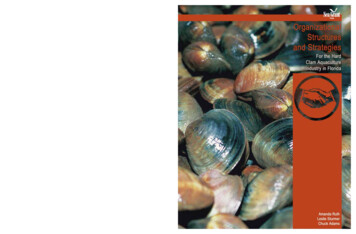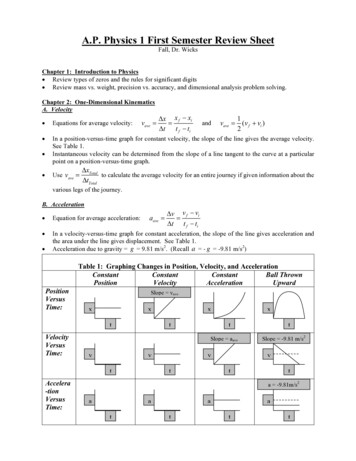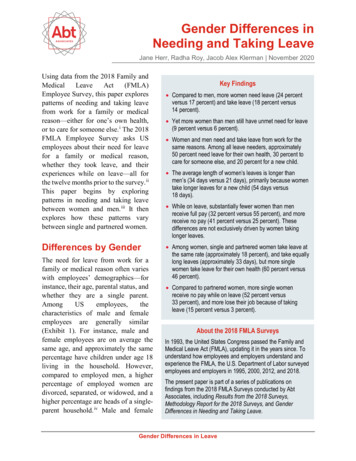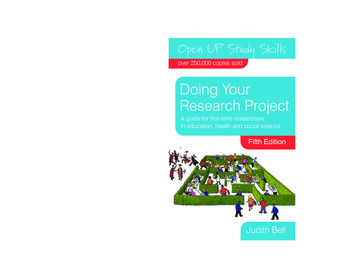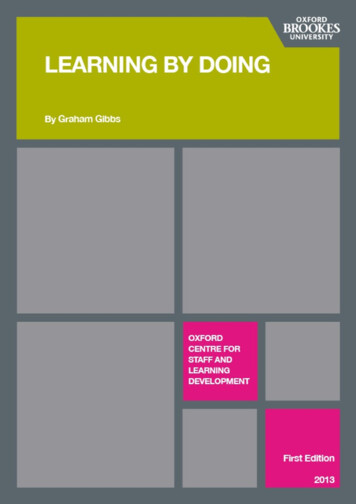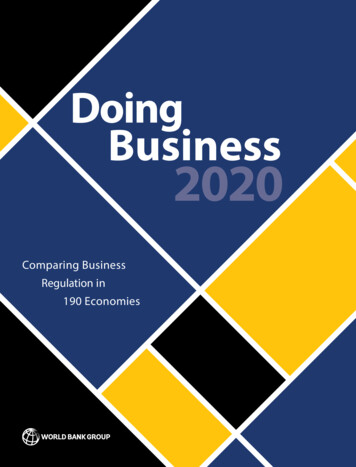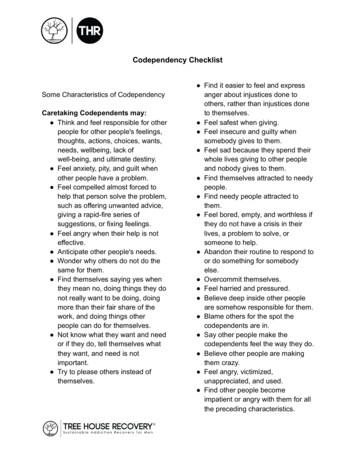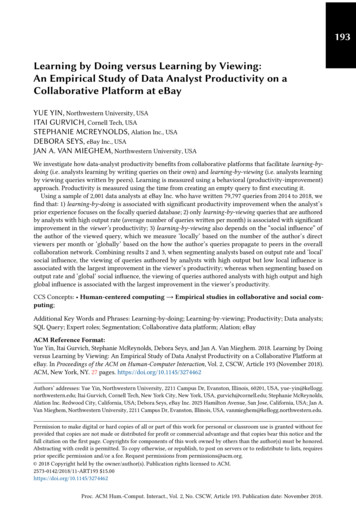
Transcription
193Learning by Doing versus Learning by Viewing:An Empirical Study of Data Analyst Productivity on aCollaborative Platform at eBayYUE YIN, Northwestern University, USAITAI GURVICH, Cornell Tech, USASTEPHANIE MCREYNOLDS, Alation Inc., USADEBORA SEYS, eBay Inc., USAJAN A. VAN MIEGHEM, Northwestern University, USAWe investigate how data-analyst productivity benefits from collaborative platforms that facilitate learning-bydoing (i.e. analysts learning by writing queries on their own) and learning-by-viewing (i.e. analysts learningby viewing queries written by peers). Learning is measured using a behavioral (productivity-improvement)approach. Productivity is measured using the time from creating an empty query to first executing it.Using a sample of 2,001 data analysts at eBay Inc. who have written 79,797 queries from 2014 to 2018, wefind that: 1) learning-by-doing is associated with significant productivity improvement when the analyst’sprior experience focuses on the focally queried database; 2) only learning-by-viewing queries that are authoredby analysts with high output rate (average number of queries written per month) is associated with significantimprovement in the viewer’s productivity; 3) learning-by-viewing also depends on the “social influence” ofthe author of the viewed query, which we measure ‘locally’ based on the number of the author’s directviewers per month or ‘globally’ based on the how the author’s queries propagate to peers in the overallcollaboration network. Combining results 2 and 3, when segmenting analysts based on output rate and ‘local’social influence, the viewing of queries authored by analysts with high output but low local influence isassociated with the largest improvement in the viewer’s productivity; whereas when segmenting based onoutput rate and ‘global’ social influence, the viewing of queries authored analysts with high output and highglobal influence is associated with the largest improvement in the viewer’s productivity.CCS Concepts: Human-centered computing Empirical studies in collaborative and social computing;Additional Key Words and Phrases: Learning-by-doing; Learning-by-viewing; Productivity; Data analysts;SQL Query; Expert roles; Segmentation; Collaborative data platform; Alation; eBayACM Reference Format:Yue Yin, Itai Gurvich, Stephanie McReynolds, Debora Seys, and Jan A. Van Mieghem. 2018. Learning by Doingversus Learning by Viewing: An Empirical Study of Data Analyst Productivity on a Collaborative Platform ateBay. In Proceedings of the ACM on Human-Computer Interaction, Vol. 2, CSCW, Article 193 (November 2018).ACM, New York, NY. 27 pages. https://doi.org/10.1145/3274462Authors’ addresses: Yue Yin, Northwestern University, 2211 Campus Dr, Evanston, Illinois, 60201, USA, yue-yin@kellogg.northwestern.edu; Itai Gurvich, Cornell Tech, New York City, New York, USA, gurvich@cornell.edu; Stephanie McReynolds,Alation Inc. Redwood City, California, USA; Debora Seys, eBay Inc. 2025 Hamilton Avenue, San Jose, California, USA; Jan A.Van Mieghem, Northwestern University, 2211 Campus Dr, Evanston, Illinois, USA, vanmieghem@kellogg.northwestern.edu.Permission to make digital or hard copies of all or part of this work for personal or classroom use is granted without feeprovided that copies are not made or distributed for profit or commercial advantage and that copies bear this notice and thefull citation on the first page. Copyrights for components of this work owned by others than the author(s) must be honored.Abstracting with credit is permitted. To copy otherwise, or republish, to post on servers or to redistribute to lists, requiresprior specific permission and/or a fee. Request permissions from permissions@acm.org. 2018 Copyright held by the owner/author(s). Publication rights licensed to ACM.2573-0142/2018/11-ART193 15.00https://doi.org/10.1145/3274462Proc. ACM Hum.-Comput. Interact., Vol. 2, No. CSCW, Article 193. Publication date: November 2018.
193:21Yin et al.INTRODUCTIONEffective data analytics drives business success by enhancing managerial decision-making. Companies often struggle to maintain growth in the productivity of their data analysts. In this paper, weinvestigate how data-analyst productivity benefits from collaborative platforms that, in addition toproviding a query-writing environment for the analysts, also facilitate access to queries authored bytheir peers. Productivity is measured using the time from creating an empty query to first executingit.Companies in various industries employ data analysts. From financial services to retailing tosocial media, data analysts aim to transform data into valuable information for decision-makers. Byretrieving, organizing and narrating raw data, data analysts can spot trends in the market, enablemanagers to know more about their consumers, and develop recommendations that are alignedwith the company’s strategy. The current demand for skilled data analysts out-paces the supply.A 2016 McKinsey Global Institute report concludes that by 2024 the U.S. economy would be inshortage of 250,000 analytics professionals [40]. Furthermore, surveyed business leaders find itchallenging to recruit and retain proficient data analysts [39].A good data analyst must be technologically up-to-date to bring insightful results swiftly [18].The writing and execution of queries is central to the work of data analysts with large-scale data.Queries are written using SQL (Structured Query Language) [71] to answer business questions like:What goods are flying off a retailer’s shelf? Who prefers to shop in a boutique store versus on-line?What are the ten most frequently searched items on eBay Motors in London in July 2017? Dataanalysts answer these questions by extracting data from the proper databases, performing datamanipulations (e.g., sorting, grouping, filtering and joining), and finally reporting the results.Proficiency in programming SQL queries is a learned skill. Organizational learning theory defineslearning as a change in the knowledge that occurs as a function of experience [31]. Such knowledgetransformation occurs at different levels in organizations — individual, group, organizational, andinter-organizational [21]. Studies have demonstrated that much of the programming knowledgeis tacit knowledge, i.e., knowledge that usually is not openly expressed or taught [83, 94]. It alsohas been established that expert programmers know more than mere syntax and semantics ofa particular language; compared to novices, their knowledge is better organized. For example,an expert programmer would be able to see the underlying commonalities and the differencesamong various problems and programs. Numerous researchers who aim to characterize expertprogramming also have suggested the existence of reusable “chunks” of knowledge representingsolution patterns that achieve different kinds of goals [56].Most current approaches measure learning by assessing changes in cognition. Qualitative methods like questionnaires, interviews and verbal-protocol analyses are typically used to that end[30, 44]. Such cognitive approaches are nonetheless unable to capture tacit knowledge [41]. Behavioral approaches measure learning by assessing changes in practices or performance and havebeen shown to capture the tacit knowledge well [6, 7, 27]. Recently more researchers start exploring a behavioral approach to quantitatively measure such ‘informal learning’ from a largeonline community. For example, Yang et al. measured learning of a Scratch user as growth in thecumulative repertoire of weighted vocabulary block use [25, 98]. We thereby deploy a behavioralapproach—measuring change in performance—in our study. The expedition of SQL programmingindicates the positive learning outcome of data analysts.In organizational learning theory, experience—typically defined as the total or cumulative numberof task completions—underpins learning. The most fundamental characterization of experienceis whether it is acquired directly by the focal organizational unit or indirectly from other units[6]. Two modes of organizational learning are derived from this characterization: learning fromProc. ACM Hum.-Comput. Interact., Vol. 2, No. CSCW, Article 193. Publication date: November 2018.
Learning by Doing versus Learning by Viewing193:3direct experience (i.e. from one’s own practices) and learning from indirect experience (i.e. fromother organizational units’ experience) [55]. Learning from direct experience is the embodimentof “practice makes perfect” while learning from indirect experience emphasizes the circulation ofknowledge among peers. Studies of the well-known learning curve provide considerable evidenceof learning from direct experience [27, 99]. There is also extensive work on collaboration andknowledge sharing that investigates learning from indirect experience [8, 36, 42, 59, 65].We study these two modes of organizational learning when eBay data analysts work on Alation.Alation is an enterprise collaborative data platform that makes data accessible to individuals acrossthe organization. The platform empowers analysts to write SQL queries using well-curated data,and allows them to publish their own queries or view any public query authored by their peers. Wefocus on two potential learning processes on Alation: learning-by-doing (“by oneself”) vs. learningby-viewing (peers’ queries) . Learning-by-doing captures how data analysts become faster the morequeries they write; how they learn from direct experience. In contrast, learning-by-viewing captureshow data analysts improve by viewing queries authored by their peers; it is an instance of learningfrom indirect experience. We pose the following research questions:1. Learning-by-doing: How is data analyst productivity associated with self-practice?2. Learning-by-viewing: How is data analyst productivity associated with viewing of queriesauthored by peers?Organizational learning theory emphasizes the role of expert in facilitating the diffusion andvalidation of credible knowledge. Previous studies have demonstrated that group members are likelyto accept and put more weight on information from a recognized expert [86]. The retaining of andthe interaction with exceptional performers appears to affect organizational outcomes [6, 16]. Giventhat most of the programming knowledge is tacit knowledge, it is not clear how to characterizeexpert (or “star”) analysts. The conventional approaches to the characterization of stars are basedexclusively on individual output [9, 38, 100]. Classic economic growth theories nonetheless claimthat human capital externalities (e.g. the influence that an individual has on the performance ofothers) are also a key input in the generation of knowledge [1, 61, 78]. Recent empirical workadopts this view and expands the traditional characterization of ‘star’ by adding measurementsof social influence [69]. Recent studies on software development gauge expertise identificationapproaches by considering the code a developer authors and the code that the developer consultsduring their work [35, 81].Inspired by the literature on the role of experts in organizational learning, we ask:3. Learning from experts: How is learning-by-viewing a query associated with the expertise of the query’s author?Our study is also related to two well-known perspectives in cognitive psychology and learningsciences [5, 19, 37]: the “within-the-human” perspective that is generally attributed to Jean Piaget[96] vs. the situated cognition perspective proposed by Jean Lave and Etienne Wenger [58]. Theformer focuses on the internalized development within the individual’s mental representation ofthe world, and presumes that knowledge can be constructed through one’s own practices [19].The latter, in contrast, suggests that knowledge is constructed in a social context, and individualparticipation in valued social practices is critical for successful learning [19, 37]. Read in our context,the within-the-human perspective would suggest that, mostly, the analyst acquires programmingknowledge from writing queries by herself (learning-by-doing). The situated-cognition perspectivesuggests, instead, that learning is mostly accomplished through the analyst’s interaction withother analysts (learning-by-viewing). For situated-cognition perspective it is needed, of course, fornewcomers to be able to observe experts. In our context Alation is the platform that facilitates thisso-called “legitimate peripheral participation” [58].Proc. ACM Hum.-Comput. Interact., Vol. 2, No. CSCW, Article 193. Publication date: November 2018.
193:4Yin et al.The rest of the paper is organized as follows. In the next section, we discuss the theory anddevelop our hypotheses. We then describe the empirical setting, data and measures. Later, wepresent our analysis strategy and report our results. We conclude with a comprehensive discussionof the results and their potential implications.2THEORY AND HYPOTHESESOrganization learning theory has been applied in a broad spectrum of industries from manufacturingto services [10, 24]. Other recent studies focus on knowledge industries like IT consulting andsoftware development [32, 48, 54]. We follow this path, relying on organizational learning theoryto develop and test hypotheses related to the learning of data-analysts working, as individuals, ona collaborative platform that facilitates knowledge sharing. Our hypotheses pertain to two modesof organizational learning: learning from direct experience and learning from indirect experience[32, 50, 75]. We use productivity as the main variable of interest and measure how it relates to theaccumulated experience that data analysts have gained by writing queries on their own (learningby-doing) and by viewing queries written by their peers (learning-by-viewing). In formulating thehypotheses we also rely on two cognitive theories of learning: learning-by-doing as it relates to thewithin-the-human perspective and learning-by-viewing as it relates to situated-learning perspective.2.1Learning by Doing2.1.1 Individual Learning from Direct Experience. Recent studies of individual learning fromdirect experience cover various industries. Kim et al. estimate the learning curve of IT consultants[54]. KC et al. examine the direct impact of a cardiologist’s own prior experience on individuallearning [50]. Staats and Gino compare the benefits of individual worker’s experience in a day orover several days [85]. They find that specialization is related to productivity improvement over asingle day. We expect data analysts in our study to benefit from their past experience of writingqueries. A positive answer to the following hypothesis further validates the earlier findings andextends them to the context of data analysts.Hypothesis 1. Past experience of writing queries is associated with an improvement in the dataanalyst’s productivity.2.1.2 Specificity of Direct Experience. Repetition of a given task is likely to improve the performance of an individual more than experience with related (but different) tasks. Boh et al. showthat specialized experience with the same system has the greatest impact on productivity formodification requests completed by individual developers [32, 48]. Such findings, identifying thebenefit of focal experience, appear in other service industries [28, 51, 85].On Alation, data analysts write queries using different databases. In an interview study by Kandelet al. focusing on the challenges of data analysts, most of the respondents mentioned the difficultyin interpreting certain database fields [46]. The evidence in the literature suggests that, as theanalyst practices more with the focal database, she will become more familiar with this database’snuances, including the field definitions, data quality and assumptions. We therefore measure theassociation between productivity and specificity of experience. A positive answer to the hypothesisbelow corroborates the value of focal direct experience in writing queries.Hypothesis 2. Past experience in querying the focal database is associated with greater improvementin data analyst productivity than past experience querying different databases.2.2Learning by Viewing2.2.1 Individual Learning from Indirect Experience. "social interaction among individuals, groupsand organizations are fundamental to organizational knowledge creation” [68]. OrganizationalProc. ACM Hum.-Comput. Interact., Vol. 2, No. CSCW, Article 193. Publication date: November 2018.
Learning by Doing versus Learning by Viewing193:5learning is frequently an interactive, social phenomenon [91]. Such communal processes are important because no one person embodies sufficient knowledge for solving all complex organizationalproblems. For instance, in the context of machine repair technicians, most of the knowledge isnot acquired in the classroom, but comes, rather, from informal story-sharing among techniciansand users about their experiences in particular work environments [15, 70]. This finding, thatindividuals also benefit from their peers’ experience (learning from indirect experience) is alsoconfirmed in [36, 42, 43, 45, 59, 65, 67, 76, 84].In the context of computer programming, Brandt et al. [11] propound that by relying on information and source code fragments provided by other people from the Web, developers engage injust-in-time learning of new skills and approaches, clarify and extend their existing knowledge, andremind themselves of details deemed not worth remembering. Vasilescu et al. [92] argue that participation in on-line programming communities (e.g. StackOverflow) speeds up code developmentsince quick solutions to technical challenges can be provided by peers. Dasgupta et al. confirmedthat remixing—defined as the reworking and combination of existing creative artifacts—acts apathway to learning [25]. They found that a learner’s repertoire of programming concepts increaseswhen she engages in remixing.Yet there is a trade-off. Viewing peers’ code may delay programming activities as both viewingand programming compete for the developer’s time and attention. Current empirical evidence forthe benefit of learning from indirect experience is inconclusive. Waldinger finds no evidence forpeer effects on the productivity of researchers in physics, chemistry and mathematics. In his study,even very high-quality scientists do not affect the productivity of their local peers [95]. KC etal. investigate the relationship between cardiologists’ current performance and the performanceof their colleagues in the same hospital [50]. But their data does not include detailed “views”information, i.e., what information individual cardiologists actually observe or share among eachother. The authors, therefore, call for future research to identify the precise micro-mechanisms atwork, exploring how knowledge is shared among individuals and affects their performance. Ourfine-grained data include a complete history of each analyst’s record of viewing specific peers’queries, offering an opportunity to respond to the authors’ call. We test the following hypothesisto measure learning from indirect experience in analysts writing queries. A positive answer tothis hypothesis confirms that it is highly possible that analysts who mostly view queries writtenby peers bear high productivity. A negative answer still leaves the possibility that only viewingqueries written by certain peers predicts high productivity. This is investigated in section 2.2.2.Hypothesis 3. Past experience of viewing queries written by peers is positively associated withdata analyst productivity.2.2.2 Characterizing Star Data Analysts. Previous studies on knowledge spillover and peer effectsamong scientists suggest a differential impact of collaborating with different types of individuals.Exceptional performers, or stars, may greatly advance the production of ideas and the innovationprocess [9, 69]. The situated-cognition theory in learning sciences places and emphasizes on therole of experts [26]. In the context of programming and software development, developers appearto have greater interest in following some prolific developers, who are considered ‘coding rockstars’by the overall community [23]. In the on-line programming community, a developer’s status canaffect decision-making. Tsay et al. find that contributions from higher-status submitters are morereadily accepted by project managers [89].In the context of data analysts, we must first ask how to identify (or characterize) the “rockstars”and, given such a characterization, how are these said stars associated with the changes in productivity of their peers? The characterization we propose in this paper differs from most existingtaxonomy by considering not just the individual output [9, 38, 100], but also the individual’s socialProc. ACM Hum.-Comput. Interact., Vol. 2, No. CSCW, Article 193. Publication date: November 2018.
Yin et al.Social Influence193:6HighMavenAll starLowNon starLone wolfLowHighIndividual Output rateFig. 1. We segment analysts using two dimensions—output rate and social influence—into four types: All-star,Lone-wolf, Maven and Non-star.influence on her peers. Such an expanded definition is unavoidable here as we wish to measurelearning-by-viewing which is an interaction-based construct. This need is also identified in [69, 89]who suggest that the characterization of “stars” should consider the individuals’ social influence[69, 89]. We introduce a two-dimensional segmentation of analysts that incorporates both a measureof the individual analyst’ output and a measure of her social influence on Alation. Relying on Oettl’scharacterization of star scientists [69] we segment analysts in our study into four types: All-star,Lone-wolf, Maven, Non-star; see Figure 1.We specify two segmentations in this paper that both use output rate yet each use a differentmeasure of social influence. We adopt the conventional measure of individual output: output-rate the average number of queries created by the analyst i per unit of time. [2, 38] Taking months asunit of time, we will use:Total number of queries i has writtenMonthly Output of Queriesi (1)Number of months since i joined in AlationWe adopt two different measures of social influence, viewership and PageRank, to describe howinfluential an analyst’s queries have been since they were written on Alation. Viewership capturesthe average number of distinct viewers per month of all queries authored by analyst i. We define:Total number of distinct data analysts who have viewed i’s queriesÍquery k written by i Months that query k is viewable(2)which represents the attention that focal analyst i receives from her peers on Alation. Viewership isa measure of the "local" influence of an author on its direct viewers. A qualitative interview studyby Dabbish et al. [23] demonstrates that, in large-scale distributed collaborations and communitiesMonthly Viewers per Queryi Proc. ACM Hum.-Comput. Interact., Vol. 2, No. CSCW, Article 193. Publication date: November 2018.
Learning by Doing versus Learning by Viewing193:7of practice (e.g. GitHub), the attention that a developer has received signals her status in thecommunity. Quoting to a representative participant in their study, “[One visible cue is] the numberof people watching a project or people interested in the project; obviously it’s a better project thanversus something that has no one else interested in it.”The second measure of social influence is PageRank, which was introduced by Google forweighting the importance of a web page based on the number and quality of links to this page[13]. To compute the PageRank of each data analyst in our study, we first build a directed, analystto-analyst network that represents the social interactions on Alation, which we explain later in3.2.2. Then, running the PageRank algorithm on this network returns the PageRank for every dataanalyst. The analyst with higher PageRank is considered more influential on the overall networkherself. While viewership captures the ‘local’ influence, PageRank represents a ‘global’ network-wideinfluence of an analyst by capturing not only her direct viewers but also the viewers of her viewersetc.We hypothesize that learning-by-viewing queries authored by analysts who outperform in bothoutput-rate and social influence is associated with the largest improvement in productivity. Toconfirm the expert roles in learning-by-viewing, we start with testing the following hypothesis.Hypothesis 4. Past experience of viewing queries written by different types of data analysts (All-star,Maven, Lone-wolf or Non-star) is associated with different change in data analyst productivity.A rejection of Hypothesis 4 would imply that the predicted productivity improvement throughviewing queries are independent of the type of the author. In contrast, support for Hypothesis 4confirms the superiority of expert roles in our context and can be followed by further investigation: which type of analysts writes the most informative queries that are associated with largestproductivity improvement of its viewers?33.1METHODSStudy PlatformWe study eBay data analysts writing and viewing queries on Alation. Alation is an enterprisecollaborative data platform developed by Alation Inc. and used by eBay Inc. As one of its clients.Alation serves as an all-inclusive ‘resort’ for data analysts. First, it provides a repository for alltechnical meta-data in the analytics data warehouse. Main data services that can connect to Alationinclude Oracle, Teradata, MySQL, SQL Server and Tableau. A data analyst can conveniently accessdata if she has the proper permissions. Second, Alation integrates various analytics tools fordata analysts to compose and execute queries, as well as produce comprehensible results. Third,Alation advances collaborations and social computing among data analysts inside eBay. A dataanalyst can share her knowledge with the community by publishing her queries, writing articlesabout her good practices or participating in conversations on technical issues. A data analyst canalso seek knowledge from the community by viewing queries authored and published by otherpeers, searching for relevant articles or asking for help in the conversation board. Serving asan on-line enterprise community, Alation supports collaboration, knowledge sharing, reuse ofresources, expertise location, innovation, organizational change and social networking [63, 64, 66,80]; Everyone in the organization, from data novices to experts, can easily search, collaborate andleverage knowledge on Alation.3.2Empirical SettingOur data consists of (1) the usage data of analysts on Alation which are automatically collectedat the back end; and of (2) the employee information data that we scripted by crawling the eBaypersonal pages of all analysts in our study. The usage data include the following informationProc. ACM Hum.-Comput. Interact., Vol. 2, No. CSCW, Article 193. Publication date: November 2018.
193:8Yin et al.Pre alphaPreliminary sourcecode has beenreleasedAlphaThe released codebegins to takeshape with moremodificationsBetaThe code isfeature complete,but retains faultsStableThe software isreliable enoughfor daily useMatureThere is no newdevelopmentoccuringFig. 2. Similar to query writing, a software development process typically starts with a "Pre-alpha" stage.spanning four years from January, 2014 to March, 2018: 1) records of entire queries on Alation, eachitem including query id, title, author, time of creation, a brief description of this query and whetherthis query has been published or not; 2) complete records of query executions on Alation, eachitem including query id, user id, time of execution and number of statements that were executed; 3)complete records of all users viewing query pages on Alation; 4) simple personal information forall users on Alation, like username, email address, date of joining the Alation platform and dateof last login. The employee information data track the public information of all data analysts inour study, including employee title, subsidiary area, manager path inside eBay, and location (citycampus, country, and building and floor).To construct our sample of data analysts, we first included all active users who have written atleast one query on Alation during our study period. We then excluded users who are labeled asAlation employees and users who are authorized as Alation administrators inside eBay Inc. We alsoexcluded users whose eBay employee information is missing on the eBay Intra-net. (That happenswhen an eBay employee left the company during the study period.) This resulted in an initial set of2059 users. We then summarized users’ hierarchies inside eBay Inc. by parsing their manager paths.Among these 2059 users, there are 17 level-1 employees, 221 level-2, 777 level-3, 748 level-4, 281level-5 and 15 level-6 (CEO is at level 10). We excluded level-6 and level-1 employees because theyare either too senior or too inexperienced to be considered as representative data analysts in ourstudy. The senior product manager who is in charge of Alation inside eBay Inc. also confirmed thatlevel 2 - 5 employees are the major users. This resulted in a final data set of 2027 users that havewritten 101327 queries during the study period. We excluded queries that have never been executedduring the study period nor exhibit missing field data; this finally left 79797 queries written by 2001data analysts for the study. It is important to point out that only about 1 out of 8 queries is everviewed by an analyst other than the author: out of the 79797 queries, only 10049 queries authoredby 1097 data analysts have been viewed by analysts other than the authors.3.3Data and Measures3.3.1 Dependent Variable. To develop a productivity measure for data analysts in our study,we borrow the concept of Pre-alpha phase from the software development l
focus on two potential learning processes on Alation: learning-by-doing ("by oneself") vs. learning-by-viewing (peers' queries) . Learning-by-doing captures how data analysts become faster the more queries they write; how they learn from direct experience. In contrast, learning-by-viewing captures


